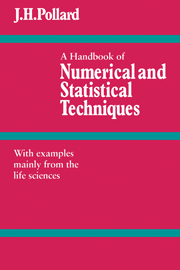Book contents
- Frontmatter
- Contents
- List of statistical and mathematical tables
- Preface
- PART I BASIC NUMERICAL TECHNIQUES
- PART II BASIC STATISTICAL TECHNIQUES
- 8 Probability, statistical distributions and moments
- 9 The normal and related distributions
- 10 The common discrete distributions
- 11 The Pearson system of probability-density functions
- 12 Hypothesis testing
- 13 Point and interval estimation
- 14 Some special statistical techniques
- PART III THE METHOD OF LEAST SQUARES
- Appendix
- References
- Author index
- Subject index
14 - Some special statistical techniques
Published online by Cambridge University Press: 18 December 2009
- Frontmatter
- Contents
- List of statistical and mathematical tables
- Preface
- PART I BASIC NUMERICAL TECHNIQUES
- PART II BASIC STATISTICAL TECHNIQUES
- 8 Probability, statistical distributions and moments
- 9 The normal and related distributions
- 10 The common discrete distributions
- 11 The Pearson system of probability-density functions
- 12 Hypothesis testing
- 13 Point and interval estimation
- 14 Some special statistical techniques
- PART III THE METHOD OF LEAST SQUARES
- Appendix
- References
- Author index
- Subject index
Summary
Summary The topics treated in this chapter fall naturally under three headings: random numbers (sections 14.1–14.3); data transformations (sections 14.4-14.7); censored and truncated distributions (sections 14.8–14.12). Topics treated under ‘random numbers’ include the generation and use of random observations on the unit interval, and transformations for obtaining random observations on other distributions. The ‘data transformation’ sections describe the arcsine, square-root, logarithmic and reciprocal transformations. Maximum likelihood methods for estimating the parameters of censored and truncated normal and Poisson distributions are described in the final portion of the chapter.
Random numbers
Problems often arise in statistical analysis which call for the use of random numbers. Survey samplers use such numbers to select random individuals from a population in order to estimate the parameters of the population. Experimental agriculturalists often find it necessary to assign different treatments (for example, fertilisers) to different blocks in a random manner in order to avoid biasing comparisons between treatments. Such an assignment relies on random numbers. Even the theoretician makes use of random numbers. He may wish to study the distribution of a complicated random variable which is defined in terms of other random variables with known distributions. Random observations on the random variables with the known distributions are generated using random numbers, and these random observations are then used to calculate random observations on the complicated random variable (example 14.1.1). Using these sample values, the theoretician can make inferences about the unknown distribution (shape, moments, etc.).
- Type
- Chapter
- Information
- A Handbook of Numerical and Statistical TechniquesWith Examples Mainly from the Life Sciences, pp. 236 - 252Publisher: Cambridge University PressPrint publication year: 1977
- 1
- Cited by



